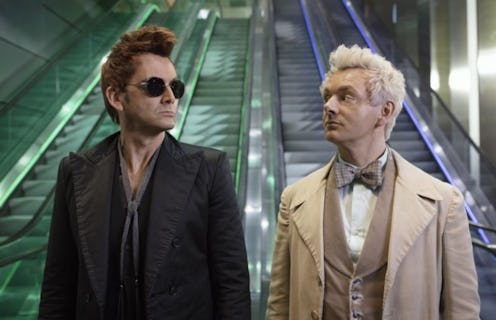Entertainment
How The 'Good Omens' Show Changes The Book's Story — For Better Or Worse

Adapting any book is hard — adapting a book as sprawling and epic as Neil Gaiman and Terry Pratchett's Good Omens verges on impossible. And yet, the BBC and Amazon Prime series has done just that: in six episodes, screenwriter Gaiman and director Douglas Mackinnon have brought to life the angel Aziraphale, the demon Crowley, and almost everything in between. Despite its elaborate premise, they spared few differences between the Good Omens book and TV show.
The rigorously faithful adaptation is, in fact, one of the more impressive things about the series. For fans worrying the show might omit their favorite moments, characters, or quips, rest assured: full monologues from the novel have made it safely to screen, including much of the book's expository narration, delivered in the series by Frances McDormand as the voice of God. This is no accident: Gaiman himself wrote all six episodes, and has spoken openly about his difficulty in deciding what to leave out from the source text — particularly when it came to the late Pratchett's contributions.
What results is a show that will delight viewers hoping to see as much of the book as possible, but potentially overwhelm those unfamiliar with it or those hoping for a more straightforward, plot-driven look at its events. Like Gaiman's American Gods, the show has opted to zoom out rather than in, adding characters and twists to a world that already overflowed with them. Nonetheless, there are a few key changes. Spoilers ahead.
1. The Show Reveals More About Crowley & Aziraphale's History
In an utterly delightful sequence at the start of Episode 3, the series walks through the making of Aziraphale and Crowley's friendship. Leaping from one major historical moment to the next (Noah's Arc, the Reign of Terror, and Nazi Germany, to name a few), the angel and demon duo go from members of opposing sides to being genuinely fond of one another. They talk about their jobs, rescue each other from near-death situations, and generally debate whether what they're doing at any moment is the "right" or "wrong" thing.
Rendered magnificently by Michael Sheen and David Tennant, Aziraphale and Crowley are the lifeline of Good Omens, and it would be impossible for this sequence not to be fun to watch. If this were a show only — or even primarily — about these two characters, it would have been perfect. But the fact remains that this series is juggling four or five plotlines, each of which must build toward the impending apocalypse. Within that context, the sequence comes off as disorienting, leaving viewers with even less of a reason to care about other equally crucial characters than they did before.
2. Archangel Gabriel Is Just A Mention In The Book
In perhaps the biggest change from the Good Omens book, the show transforms a half-hearted mention of the archangel Gabriel into a prominent character, played with tremendous levity by Jon Hamm. According to Gaiman, he and Pratchett had discussed a Good Omens sequel, in which Gabriel plays a larger role. Gaiman says he used the series as a way to include characters from that never-completed sequel and have them "do the things they would have done" had they written a follow-up.
In the book, the mention of Gabriel is limited to an offhand comment by Aziraphale: "'If you really want Gabriel or someone wondering why 40 policemen have gone to sleep,'" he warns, suggesting that performing too many miracles will get him in trouble with a higher authority. In the series, Gabriel is Aziraphale's boss, regularly checking in on the angel's progress and growing suspicious of his activities on Earth.
Hamm's Gabriel is a high point of the show: his comedic timing combined with its bureaucratic, Good Place-esque depiction of heaven does offer a fair bit of humor — but then, so do most of the included characters. Aziraphale's storyline is certainly brightened by the inclusion of Gabriel, but ultimately, he does little to further the plot, and his screen time might have been better spent on building some urgency toward the impending apocalypse.
3. The Show Makes An Effort To Correct Some Racial Blunders
As a fantasy novel published in the '90s by two middle-aged white men, Good Omens, unsurprisingly, suffered from some racially insensitive missteps. However, Gaiman and Mackinnon smartly course-corrected for the series, avoiding the inclusion of "Geronimo," a Native American spirit guide from the book.
They also seem to have taken care to include a racially diverse cast of characters. While Adam Young's friend Pepper is described in the book as having red hair and freckles, leading many to assume she would be played by a white actress, they cast an actress of color (Amma Ris) instead. Per Screen Rant, Gaiman and Mackinnon said at New York Comic Con that they made a conscious decision to cast people of color in the roles of Adam and Eve, as well as have gender and racial diversity amongst the various angels and demons.
That being said, members of the cast — particularly those with speaking roles — are still overwhelmingly white. This is a common frustration with the fantasy genre, which is often accused of a rich imagination in all fields except the possibility of telling non-white stories. But knowing that the director and writer were at least aware of this issue, and felt compelled to act on that awareness, is a positive step.
For avid Gaiman readers, Good Omens is still required viewing. And for those particularly in love with the voice of the novel, the series will check all the same boxes of wit and tongue-in-cheek exposition. It's unlikely that Good Omens will keep you on the edge of your seat, but it does present an opportunity to languish in an elaborate and well-drawn fantasy world. If this was Gaiman's intention, he's certainly succeeded.